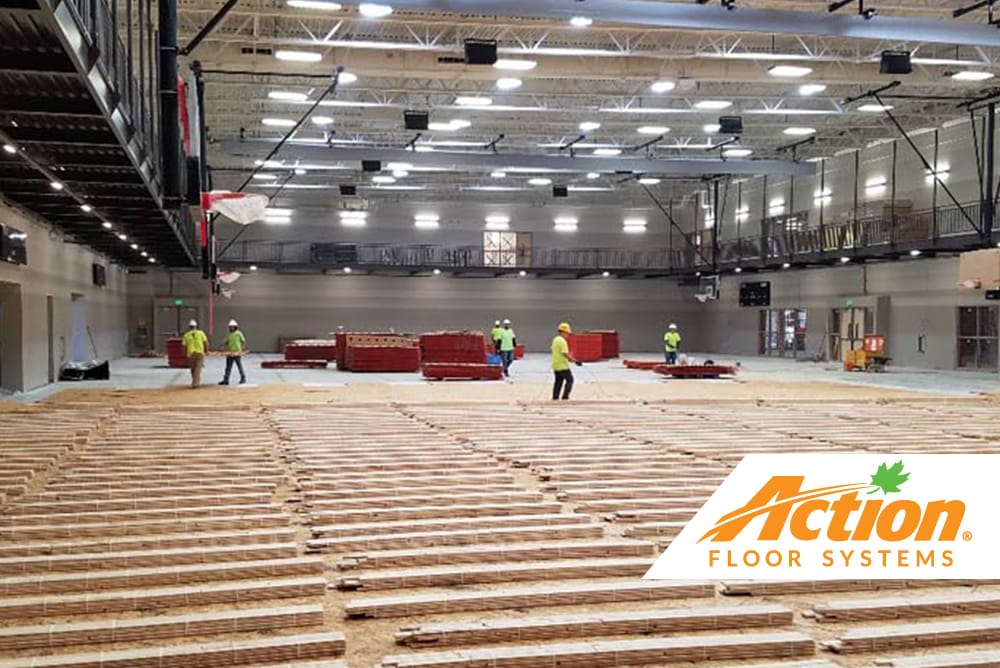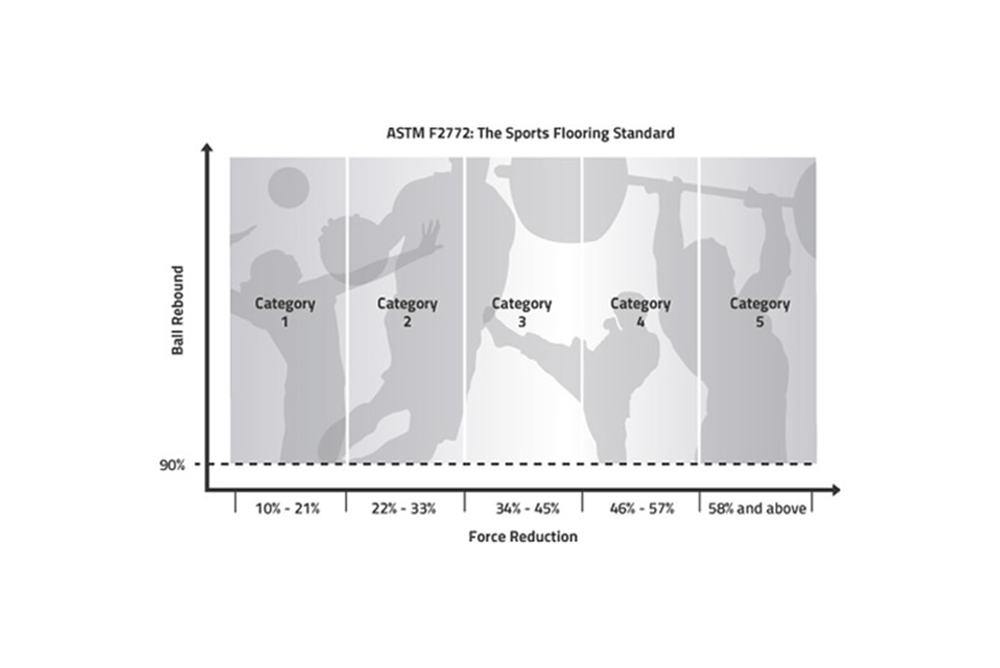
Image courtesy of Arizona Hardwood
Specifying floating floor systems within a sports facility design is a routine practice for architects. However, the basic performance criteria of floating floor systems are not widely understood by their clients. We developed this resource that can be used as a guide for understanding and explaining the performance attributes of floating floor systems.
For starters, what exactly are floating floor systems? Floating floor systems are sports floors that are not fastened to the concrete slab or substrate system. The floor system, in essence, “floats” on top of the slab. Floating floors typically feature rubber pads or foam as a base layer, followed by two layers of sheathing or sleepers, and the maple-finish floor. They are also ideal for areas with moisture concerns as they do not have anchoring or retention pins that would penetrate a topically applied or sheet-type moisture retarder.
Starting the Process
When designing to replace an older floor as part of a remodel, or designing a first-time installation, floating floor systems can accommodate a variety of situations related to sports facilities, but they’re not simply a fill-in-the-blank product. Knowing some background information on the area of the flooring will go a long way in helping specify the right solution.
Find out:
- Who will be using the floor?
- What activities will occur on it?
- How often will the facility be used in an average year?
- Will the floor experience long idle periods?
- What is the climate in the area of the installation?
- What types of HVAC systems will be in the space?
- Is the installation below-grade, on-grade, or above-grade?
Next, the following points are essential in developing the optimum specification decisions:
Slab Depression/Floor Elevation Requirements
Whether the subfloor design is low or high-profile, sports flooring system profiles are not necessarily an indication of surface performance characteristics. Maple sports floor manufacturers can provide slab depression requirements for subfloor systems.
Differences in Floating Floor Types
There are a variety of floating floor system types designed to accommodate particular flooring area and use requirements. Each system type includes different specs, from wide-body sleepers, two layers of sheathing, and laminated sleepers, that provide cushioning, humidity control, and other potential needs. Within each of those flooring system types, further modifications are possible to create the ultimate solution for your plans.
Appearance
Your clients should clarify what they want their floors to look like once they are installed. This will allow you and the sports floor contractor to recommend the appropriate grade of maple, paints, and finishes that are consistent with what your client envisions.
Cost
The installed cost of floating sports floor systems varies based on the subfloor system the project requires, as well as the maple grade of the finished floor. Consider the cost from two perspectives: installed cost and life-cycle cost. Always remember that a lower upfront cost is not a savings if the floor will need to be repaired or replaced sooner than later.
Relying on ASTM Standards
Once you have all the previous information gathered, how can you trust that the quality of the flooring you specify will be up to par? Fortunately, standards and certifications help differentiate which floors meet all the criteria you need, so that you can easily make confident selections for your plans.
The American Society for Testing and Materials (ASTM) provides over 12,000 standards globally for products, and ASTM F2772 provides specification for athletic performance properties of indoor sports floor systems. To meet this standard, floor systems are evaluated based on four criteria:
- Shock absorption: A floor system’s ability to reduce impact. A higher shock absorption means a safer floor for athletes of all ages. ASTM F2772 has established criteria for any floor designed for indoor athletics.
- Vertical deformation: A floor system’s ability to give during a jump or fall. Unlike shock absorption, too much vertical deformation makes a floor unstable, but too little can cause injuries. Acceptable values are specific to each flooring system, but wood flooring is classified into either an inclusive or exclusive range. The inclusive Class A represents values between 0.071”-0.197” (1.8 mm – 5.0 mm) and exclusive Class B represents values <0.071” (<1.8 mm).
- Ball rebound: This criteria refers to the accuracy of vertical ball bounce and is tested according to ASTM F2117. It considers two parameters:
- Performance level: Minimum of 90% average in test results.
- Uniformity level: Test point deviation cannot exceed 3% of the average of all tests.
- Sliding effect: Surface friction is tested according to ASTM E303 in order to ensure safe movement and pivoting. Testing for this also considers two parameters:
- Performance level: Must achieve a value between 80-110.
- Uniformity level: Individual tests cannot vary more than 4 points from the average value.
 Image courtesy of Advantage Sport
Image courtesy of Advantage Sport
Action Excel NR, ProAction Thrust, and Action Interloc II floating floor systems meet these standards. Specifying flooring that meets ASTM standards helps make the specification process easier. Informing your client of what the standards represent during the design process is the ideal time to build their understanding of the difference in quality they’ll receive based on your plans.
Long-lasting and safe flooring helps support a quality design, provides users a better experience, and can help a sports facility save costs on maintenance and liability over time due to the material being more consistent, higher quality, and safer.
The Value of MFMA Compliance
A study conducted by the Maple Flooring Manufacturers Association (MFMA), found that 46% of architects’ clients lacked understanding about various flooring options. They also found that 31% of architects had challenges finding tools and resources to assess sports flooring options that best met specific project requirements. These are signs that there are likely many sports facilities that haven’t gotten the optimal type of flooring installed because the process lacked guidance.
The MFMA is working to change that. They’ve developed MFMA PUR, which supports and enforces standards similar to those of ASTM. Products that meet these standards are now labeled with MFMA PUR Compliance, making it easy for architects to distinguish which products cover the criteria needed for the specification.
Based on shock absorption, vertical deflection, area of deflection, ball rebound and surface friction, MFMA PUR uses third party floor testing who share the data with MFMA reviewers to determine if a floor system is compliant based on a strict pass-or-fail evaluation. Using third party testing helps ensure that flooring systems of MFMA members don’t automatically get approved. Each floor system must pass the third party test in order to be compliant.
When specifying floor systems that are MFMA PUR Compliant, architects can explain to their clients that their sports floors will provide better performance, uniformity, and playability due to the attributes that are “built-in” to the compliance. Designing a beautiful new facility that contains the right flooring for the right activities will create a better experience for users, encourage use of the space, and be a better resource for the community.
“Action Floors have a consistency in the floating floors they make. Every time a floor is made, it’s always the same. We have high Quality Control in our factory that results in uniformity throughout each surface, so that installed floors are the same in one area as they are in another. A floor should feel the same no matter where an athlete is on the floor.”
– Don Brown, Action Floors
Finding a Design Partner
Action Floors is an expert resource that can guide you to make the optimum sports floor selections and clearly communicate the reasoning and benefits to your clients. Call or email us with any questions you might have. We’re here to help.


















